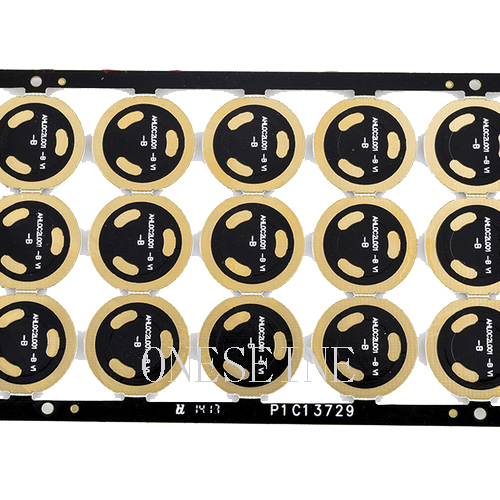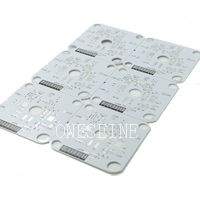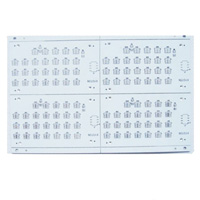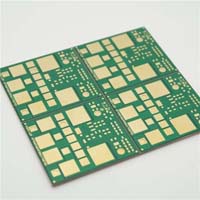Printed Circuit Boards
High Heat Conductivity Single layer Black LED PCB Metal Core Printed Circuit
- High Heat Conductivity
- high temperature pcb
- Product description: pcb thermal conductivity how to reduce heat on pcb pcb temperature limits conduction cooled pcb high temperature pcb pcb heat dissipation techniques fr5 pcb pcb thermal management
High Heat Conductivity Single layer Black LED PCB Metal Core printed circuit board Fabrication
Quick Details
Place of Origin:Guangdong, China (Mainland)
Brand Name:ONESEINE
Application:LED
Number of Layers:1 layer
Base Material:Aluminum Base
Copper Thickness:0.5-6oz
Board Thickness:0.6-3.0mm
Min. Hole Size:0.20mm
Min. Line Width:0.10mm
Min. Line Spacing:0.08mm
Surface Finishing:HAL/OSP/Immersion Gold Plating/Gold Plating/Sn Plating/Immersion Sn
Other Service:pcb with led Assembly Service
Standards:UL&ROHS&CE&ISO
Service:OEM&ODM
substrates material:aluminum/copper
Combustibility:94v0
Special technology:BGA can be 2.5mil, aperture(min)0.075mm,MID
Breakdown voltage:2-4.5v
thermal conductivity:1.0-3.0w/m.k
Metal Core PCB:
Metal Core PCB Fabrication includes the design and production of printed circuit boards (PCB's) with a metal core, intended for use with LED-based Solid State Lighting and other applications where heat dissipation is required.
Oneseine Company
Metal Core PCB means the core (base) material for PCB is the metal, not the normal FR4/CEM1-3, etc. and currently the most common metal used for MCPCB manufacturer are Aluminum, Copper and steel alloy. Aluminum has good heat transferring and dissipation ability, but yet relatively cheaper; copper has even better performance but relatively more expensive, and steel can be divided into normal steel and stainless steel. It more rigid than both aluminum and copper, but thermal conductivity is lower than them too. People will choose their own base/core material according to their different application.
Generally speaking, aluminum is the most economic option considering thermal conductivity, rigidness, and cost. Therefore, the base/core material of normal Metal Core PCB are made of aluminum. In our company, if not special request, or notes, the metal core refer will be aluminum, then MCPCB will means Aluminum Core PCB. If you need Copper Core PCB, Steel Core PCB, or Stainless steel core PCB, you should add special notes in drawing.
Sometimes people will use abbreviation “MCPCB”, instead of the full name as Metal Core PCB, or Metal Core Printed Circuit Board. And also used different word refers the core/base, so you will also see different name of Metal Core PCB, such as Metal PCB, Metal Base PCB, Metal Backed PCB, Metal Clad PCB and Metal Core Board and so on.(oneseine.com)
MCPCBs are used instead of traditional FR4 or CEM3 PCBs because of the ability to efficiently dissipate heat away from the components. This is achieved by using a Thermally Conductive Dielectric Layer.
The main difference between a FR4 board and MCPCB is the thermal conductivity dielectric material in the MCPCB. This acts as a thermal bridge between the IC components and metal backing plate. Heat is conducted from the package through the metal core to an additional heat sink. On the FR4 board the heat remains stagnant if not transferred by a topical heatsink. According to Avago’s white paper (AV01-0615EN.pdf) a MCPCB with a 1W LED remained near an ambient of 25C, while the same 1W LED on a FR4 board reached 12C over ambient. LED PCB always be produced with Aluminum core, but sometimes steel core PCB also be used.
Benefits of Metal Core PCB Fabrication
Metal Core PCB Fabrication presents a host of beneficial features for a variety of applications. A lower thermal resistance can be achieved as a result of MCPCB's which incorporate a dielectric polymer layer together with a high thermal conductivity level.
Metal Core PCB Fabrication produces a product that transfers heat up to nine times more rapidly than a typical FR4 PCB. The laminates in MCPCB's dissipate heat which ensures that components which generate heat will remain cooler. This leads to a longer operating life as well as maximized performance for such components.
Applications of Metal Core PCB Fabrication
With the adoption of new technologies, there are many more applications for Metal Core PCB Fabrication. This technology is ideal for applications where components generate a large amount of heat and have difficulty being cooled using conventional fans and other cooling methods. In Solid State Lighting, MCPCB's help achieve a higher level of illumination with fewer LED's required to produce it.
Although LED-based Solid State Light technologies have countless advantages, they inherently produce significant amounts of heat. This makes Metal Core PCB Fabrication helpful for applications like:
General Lighting
Automotive Systems
Power Converters (industrial, telecom, power supplies, and high voltage regulators)
Photovoltaic
Street Safety (lighting, streetlights, etc.)
Back Light Applications
Aluminum PCB:
Aluminum PCB Advanced Circuits Specification
Among all Metal core PCBs (aka MCPCBs, known for their ability to provide effective thermal dissipation for electronic products), Aluminum PCBs is the most common type - the base material consists of aluminum core with standard FR4. It features a thermal clad layer that dissipates heat in a highly efficient manner, while cooling components and increasing the overall performance of the products. Currently, Aluminum Backed PCBs is regarded as the solution to high power and tight tolerance applications.
Oneseine's been manufacturing aluminum PCBs for 10+ years. Our full feature aluminum circuit boards making capabilities and Free DFM Check allow you to get high-quality aluminum PCBs done within budget. Our printed Aluminum PCBs are widely used for LED lighting, power equipment and automotive systems.
Categories
Latest News
Contact Us
Contact: Ms Tracy
Phone:
Tel:
Add: BludingA,Shixiaganglian Industrial Park,Shajing,Baoan,Shenzhen,China




 Tracy
Tracy